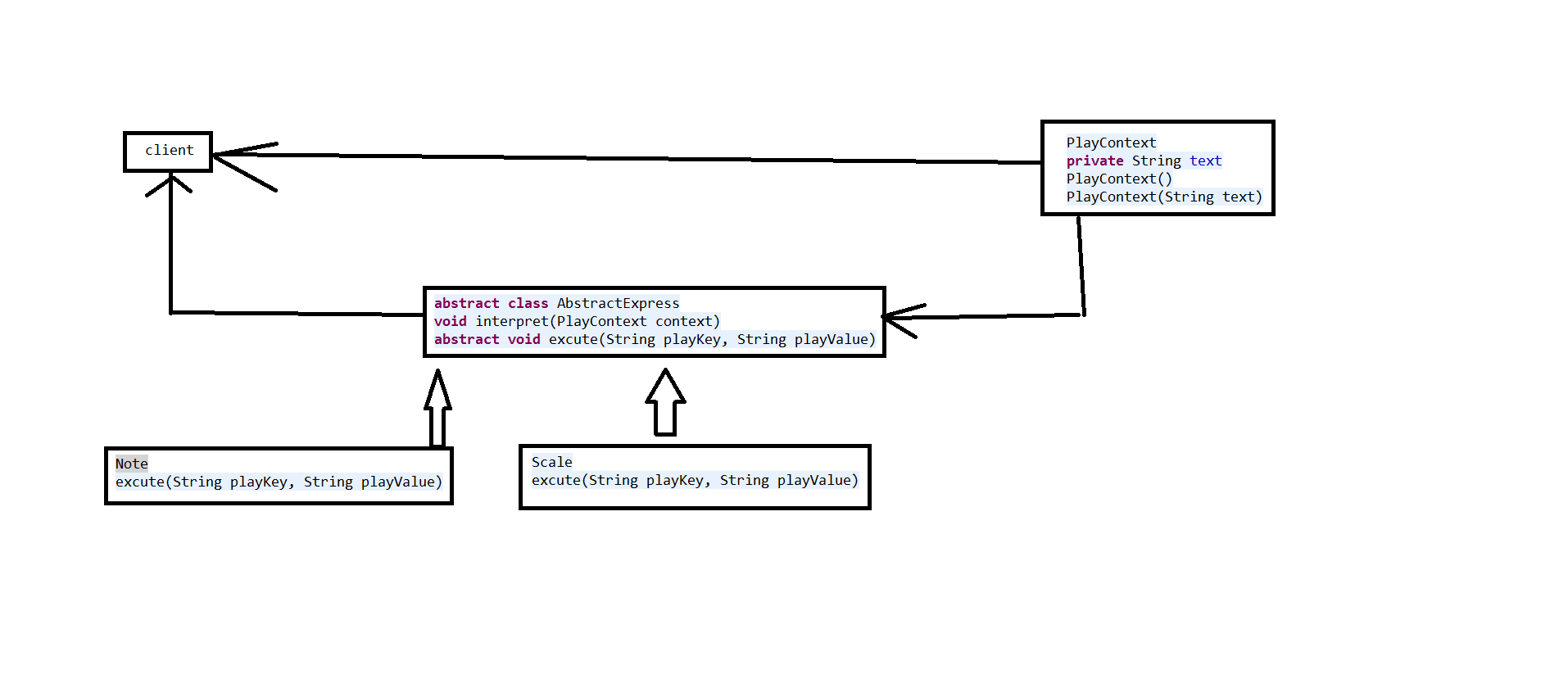
1 package com.shejimoshi.behavioral.Interpreter; 2 3 4 /** 5 * 功能:演奏文本 6 * 时间:2016年3月3日上午9:26:19 7 * 作者:cutter_point 8 */ 9 public class PlayContext 10 { 11 private String text; 12 13 public PlayContext() 14 { 15 } 16 17 public PlayContext(String text) 18 { 19 this.text = text; 20 } 21 22 public String getText() 23 { 24 return text; 25 } 26 27 public void setText(String text) 28 { 29 this.text = text; 30 } 31 32 }
1 package com.shejimoshi.behavioral.Interpreter; 2 3 4 /** 5 * 功能:抽象表达式 6 * 时间:2016年3月3日上午9:28:02 7 * 作者:cutter_point 8 */ 9 public abstract class AbstractExpress 10 { 11 //解释器,吧我们的表达式进行分解 12 public void interpret(PlayContext context) 13 { 14 if(context.getText().length() == 0) 15 { 16 return; //这个表示表达式长度为0,没有需要处理的 17 } 18 else 19 { 20 //这里吧 O 3 E 0.5 G 0.5 A 3 转化为 E 0.5 G 0.5 A 3 21 String playKey = context.getText().substring(0, 1); 22 context.setText(context.getText().substring(2)); //3 E 0.5 G 0.5 A 3 23 String playValue = context.getText().substring(0, context.getText().indexOf(" ")); 24 context.setText(context.getText().substring(context.getText().indexOf(" ") + 1)); //E 0.5 G 0.5 A 3 25 26 //执行解释器 27 excute(playKey, playValue); 28 } 29 } 30 31 public abstract void excute(String playKey, String playValue); 32 }
1 package com.shejimoshi.behavioral.Interpreter; 2 3 4 /** 5 * 功能:音符类 6 * 时间:2016年3月3日上午9:40:33 7 * 作者:cutter_point 8 */ 9 public class Note extends AbstractExpress 10 { 11 12 @Override 13 public void excute(String playKey, String playValue) 14 { 15 String note = ""; 16 switch(playKey) 17 { 18 case "C": 19 note = "1"; 20 break; 21 case "D": 22 note = "2"; 23 break; 24 case "E": 25 note = "3"; 26 break; 27 case "F": 28 note = "4"; 29 break; 30 case "G": 31 note = "5"; 32 break; 33 case "A": 34 note = "6"; 35 break; 36 case "B": 37 note = "7"; 38 break; 39 } 40 41 System.out.print(note + " "); 42 } 43 }
1 package com.shejimoshi.behavioral.Interpreter; 2 3 4 /** 5 * 功能:音符类 6 * 时间:2016年3月3日上午9:48:49 7 * 作者:cutter_point 8 */ 9 public class Scale extends AbstractExpress 10 { 11 12 @Override 13 public void excute(String playKey, String playValue) 14 { 15 String scale = ""; 16 switch(playValue) 17 { 18 case "1": 19 scale = "低音"; 20 break; 21 case "2": 22 scale = "中音"; 23 break; 24 case "3": 25 scale = "高音"; 26 break; 27 } 28 29 System.out.print(scale + " "); 30 } 31 32 }
1 package com.shejimoshi.behavioral.Interpreter; 2 3 4 /** 5 * 功能:解释器模式,给定一个语言,定义它的文法的一种表示,并定义一个解释器,这个解释器使用该表示来解释语句中的句子 6 * 适用:当有一个有一个简单的语法规则,比如一个sql语句,如果我们需要根据sql语句进行rm转换,就可以使用解释器模式来对语句进行解释。 7 一些重复发生的问题,比如加减乘除四则运算,但是公式每次都不同,有时是a+b-c*d,有时是a*b+c-d,等等等等个,公式千变万化, 8 但是都是由加减乘除四个非终结符来连接的,这时我们就可以使用解释器模式。 9 * 时间:2016年3月3日上午8:43:58 10 * 作者:cutter_point 11 */ 12 public class Test 13 { 14 public static void main(String[] args) 15 { 16 // String str = "tes asd"; 17 // System.out.println(str.substrin